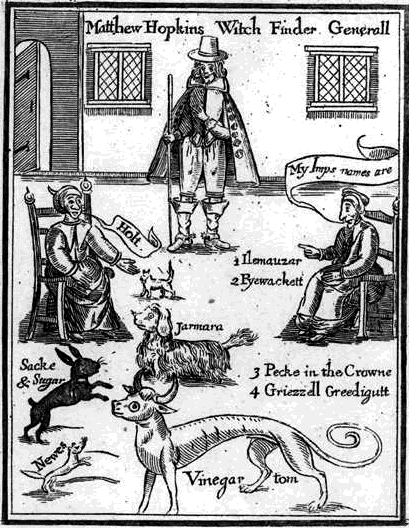 |
| Prince Rupert and his "familiar" dog in a pamphlet titled "The Cruel Practices of Prince Rupert" (1643). |
마녀나 주술사들은 으레 수족처럼 부려먹을 똘마니들을 만든다. 그렇게 만들어진 사역마들은 자신을 만들어준 존재에게 맹목적 충성을 바친다. 절대적 주종관계다. 물론 제 주인들과 마찬가지로 사악한 존재들이다. 얼마 전에 소개한 ‘지루박 추던 박근혜의 곰새끼’도 일종의 사역마다.
똘마니 제조법은 다양하다. 동물을 최면에 빠트린다. 악귀와 친한 검은고양이나 까마귀같은 놈들을 주로 이용한다. 부적이나 호리병 따위에 갖힌 악귀를 풀어주고 똘마니로 부리는 경우도 있다. 생긴 건 사람인데, 껍데기만 사람인 사역마를 만들기도 한다. 사역마의 가장 큰 역할은 뭘까. 주인을 지켜주는 지킴이 역할이다.
 |
| 일본의 개귀신 이누가미도 사역마 가운데 하나. |
사역마는 지성, 감정이 없다. 지성과 감정이 있으면 맹목적 충성을 기대할 수 없기 때문이다. 그냥 박근혜나 이명박이 시키는대로 움직인다. 또한 마녀나 주술사는 사역마에게 자신의 초능력이나 권력의 일부를 준다. 하지만 자신을 능가하는 힘을 주는 법은 결코 없다. 혹시라도 배신하여 덤벼들면 큰일 아닌가.
조현천 등은 박근혜의 사역마였을까. 그들은 지성도 감정도 없이 박근혜에게 맹목적 충성을 바친 것일까. 박근혜가 그들에게 보장해준 힘은 어느 정도였을까. 자신을 능가하는 힘을 주지는 않았겠지. 그렇다면 계엄령 어쩌구 하는 얘기도 결국 박근혜의 입에서 먼저 나온 게 아닐까.
 |
| late 16th-century English illustration of a witch feeding her familiars. |
(부록)
사역마
使役魔. 使い魔, familiar spirits. 마녀, 주술사에게 절대복종하는 정령, 동물 따위. In European folklore and folk-belief of the Medieval and Early Modern periods, familiar spirits (sometimes referred to simply as "familiars" or "animal guides") were believed to be supernatural entities that would assist witches and cunning folk in their practice of magic. they would appear in numerous guises, often as an animal, but also at times as a human or humanoid figure. The main purpose of familiars is to serve the witch or young witch, providing protection for them as they come into their new powers.
정보수집
촛불정보 수집. The medicine man sends his familiar spirit to gather the information. While this is occurring, the man himself is in a state of receptivity, in sleep or trance.
유럽의 경우
Familiars are most common in western European mythology, with some scholars arguing that familiars are only present in the traditions of Great Britain and France. In these areas three categories of familiars are believed to exist:
- human familiars, throughout Western Europe
- divinatory animals, Great Britain and France
- malevolent animals, only in Greece
사역마는 개다
결국 개는 깨갱하고 사망하심. Prince Rupert and his "familiar" dog in a pamphlet titled "The Cruel Practices of Prince Rupert" (1643). During the English Civil War, the Royalist general Prince Rupert was in the habit of taking his large poodle dog named Boye into battle with him. Throughout the war the dog was greatly feared among the Parliamentarian forces and credited with supernatural powers. As noted by Morgan, the dog was apparently considered a kind of familiar. At the end of the war the dog was shot, allegedly with a silver bullet.
 |
| Frontispiece from the witch hunter Matthew Hopkins' The Discovery of Witches (1647), showing witches identifying their familiar spirits. |
작은 악귀들
Familiar spirits were most commonly small animals, such as cats, rats, dogs, ferrets, birds, frogs, toads, and hares. There were also cases of wasps and butterflies, as well as pigs, sheep, and horses. Familiar spirits were usually kept in pots or baskets lined with sheep’s wool and fed a variety of things including, milk, bread, meat, and blood.
관리자 freemediaf@gmail.com
<저작권자 © 자유언론실천재단, 무단 전재 및 재배포 금지>

